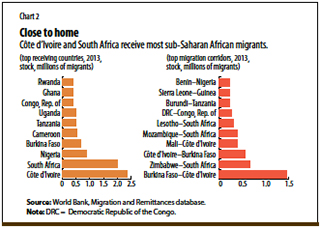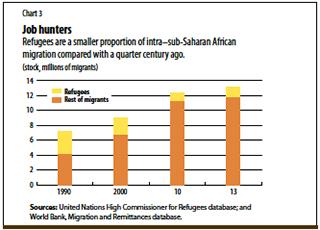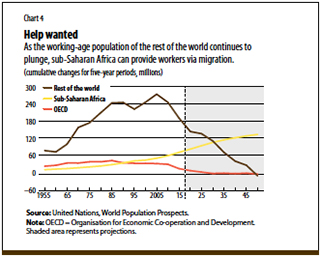Beyond the Headlines
Finance & Development, June 2017, Vol. 54, No. 2
Jesus Gonzalez-Garcia and Montfort Mlachila
Migration from sub-Saharan Africa has far-ranging effects on home and host countries alike

International migration has been in the headlines for the past few years: a surge of refugees to Europe, especially from the Middle East and Africa, has spurred the ongoing refugee crisis. A backlash has followed in many countries, including within sub-Saharan Africa.
Developing economies tend to receive more immigrants relative to their population than advanced economies. Refugees make the headlines, but in sub-Saharan Africa longer-term migration, within and outside the region, strongly affects the continent’s economies.

In 2013, about 20 million sub-Saharan Africans, twice the 1990 number, were living outside their own country—13 million of whom had migrated within the region (see Chart 1).
The demographic boom in sub-Saharan Africa’s working-age population—which typically feeds migration—means the trend will continue for decades. The current 2 percent migration rate (migrants as percent of population) in sub-Saharan Africa is low relative to the rest of the developing world, where 3 percent of the population live abroad. But it has kept up with the rapid growth of the region’s population as a whole—from about 480 million in 1990 to about 900 million in 2015.
Where are they going?

Most migration occurs within the region (see Chart 2). People who move for economic reasons tend to look for opportunity in wealthier neighboring countries.
Why do Africans move to other African countries proportionately more than to richer countries? One reason is economics. The poor cannot afford a plane ticket to Europe or the United States, but they can jump on a bus or truck, and borders within Africa are porous. Cultural and linguistic affinity also plays a role.
Forced migration
The number of refugees—people fleeing war or persecution—is much lower in Africa since 1990, both within and outside the region. About half of migrants were refugees in 1990, down to about 10 percent by 2013 thanks to fewer large-scale conflicts in the region (see Chart 3).

Five conflict-affected countries are the main sources of intra-African refugees: the Central African Republic, the Democratic Republic of the Congo, Somalia, Sudan, and South Sudan. Those from Somalia found refuge in Kenya and Ethiopia, refugees from Sudan migrated to Chad, and South Sudanese have been largely displaced within their own country and have gone to Uganda. Sub-Saharan Africa hosts the largest refugee camps in the world, with substantial fiscal costs for the host countries, estimated at 1 to 5 percent of GDP.
Both forced migration and migration for economic reasons can bring friction. The cost of hosting refugees and social tension in countries receiving large numbers of migrants seeking jobs, services, and opportunities can be difficult to manage.
Migration to the rest of the world is growing faster than within the region. About 6.6 million sub-Saharan African migrants—one-third of the total—lived outside the region in 2013, more than double the number in 1990. The composition has changed markedly: in 1990 about 40 percent moved for economic reasons, which had risen by 2013 to 90 percent. But the rate of global migration in sub-Saharan Africa is the lowest in the world, at 0.7 percent of the region’s total population. That rate is about seven times larger in Latin America and the Caribbean and four times larger in the Middle East and northern Africa.
Why move?
Migration within Africa is driven mostly by geographic proximity, differences in income, and war in the home country, along with cultural links and environmental factors such as droughts or floods. Côte d’Ivoire and South Africa are among the recipients of the largest number of intraregional migrants.
Migration to the rest of the world is driven mainly by economic opportunity, and the primary destinations are advanced economies. About 85 percent of the sub-Saharan African diaspora is in countries belonging to the Organisation for Economic Co-
operation and Development (OECD)—France, the United Kingdom, and the United States host about 50 percent of sub-Saharan African migrants.
Remittances are the biggest benefit for home countries. Inflows of money from expatriates have increased rapidly and are now one of the largest sources of external finance for developing economies, at 3½ percent of GDP in 2015. Remittances have leapfrogged foreign direct investment as the largest source of foreign exchange for developing economies, partly because the latter has declined sharply.
Remittances tend to be more resilient during economic downturns than foreign direct investment and official development assistance. After the global financial crisis, they dropped slightly in 2008 and 2010, recovered in 2011, and have grown ever since.
Remittances play an important macroeconomic role in sub-Saharan Africa. They are a source of foreign exchange and income, contributing more than 20 percent of GDP in The Gambia, Lesotho, and Liberia. They supplement the income of poor households, which can save some to invest in human and physical capital, which raises productivity and growth over time. Remittances also help mitigate the effects of macroeconomic shocks from natural disasters and conflict.
But emigration does harm the home country. The brain drain following the departure of skilled and qualified workers reduces productive capacity and long-term growth.
Evolving demographics

The demographic transition in the region will shape future migration. Not only will the region’s population continue to increase—from about 900 million in 2013 to 2 billion in 2050—but the working-age population, which typically feeds migration, is set to increase even faster—from about 480 million in 2013 to 1.3 billion in 2050 (see Chart 4). This reflects the region’s continued population growth—total population has increased fourfold since the 1960s—declining fertility rate, and lower infant mortality rate, which is half what it was in 2000.
These demographic trends and persistently large income gaps between sub-Saharan African and advanced economies will likely drive more migration. The ratio of sub-Saharan African migrants to the total population of their new homes in OECD countries is projected to increase sixfold, from about 0.4 percent in 2010 to 2.4 percent by 2050—through a combination of more migration from the region and slow expected population growth in the OECD.
Better policies
Migrant workers can help receiving countries grow, especially where the population is aging rapidly (Jaumotte, Koloskova, and Saxena 2016). They bring additional tax revenues and social contributions in their new homes to support retired workers. Remittances will continue to support relatives’ living standards, help alleviate poverty, and play a role as a stable source of foreign exchange.
Since migration within and outside sub-Saharan Africa will likely continue to expand in the coming decades, countries must design policies that help migrant workers adapt socially and economically in the host economies for all to benefit.
Population growth calls for policies that generate jobs in home countries. In countries receiving migrants, the boost to the labor force should compensate for aging and declining domestic populations, which is good for both economic growth and taxes in the long run. The boost to growth and taxes should ease social tension from concern about displacement of native workers and fiscal costs while increased international support to countries that host refugees would go a long way toward reducing fiscal and other related social costs.
JESUS GONZALEZ-GARCIA is a senior economist in the IMF’s African Department, and MONTFORT MLACHILA is the IMF’s senior resident representative in South Africa.
References
Gonzalez-Garcia, Jesus, and others. 2016. “Sub-Saharan African Migration: Patterns and Spillovers.” IMF Spillover Note 9, International Monetary Fund, Washington, DC.
Jaumotte, Florence, Ksenia Koloskova, and Sweta Saxena. 2016. “Impact of Migration on Income Levels in Advanced Economies.” Spillover Note 8, International Monetary Fund, Washington, DC.


